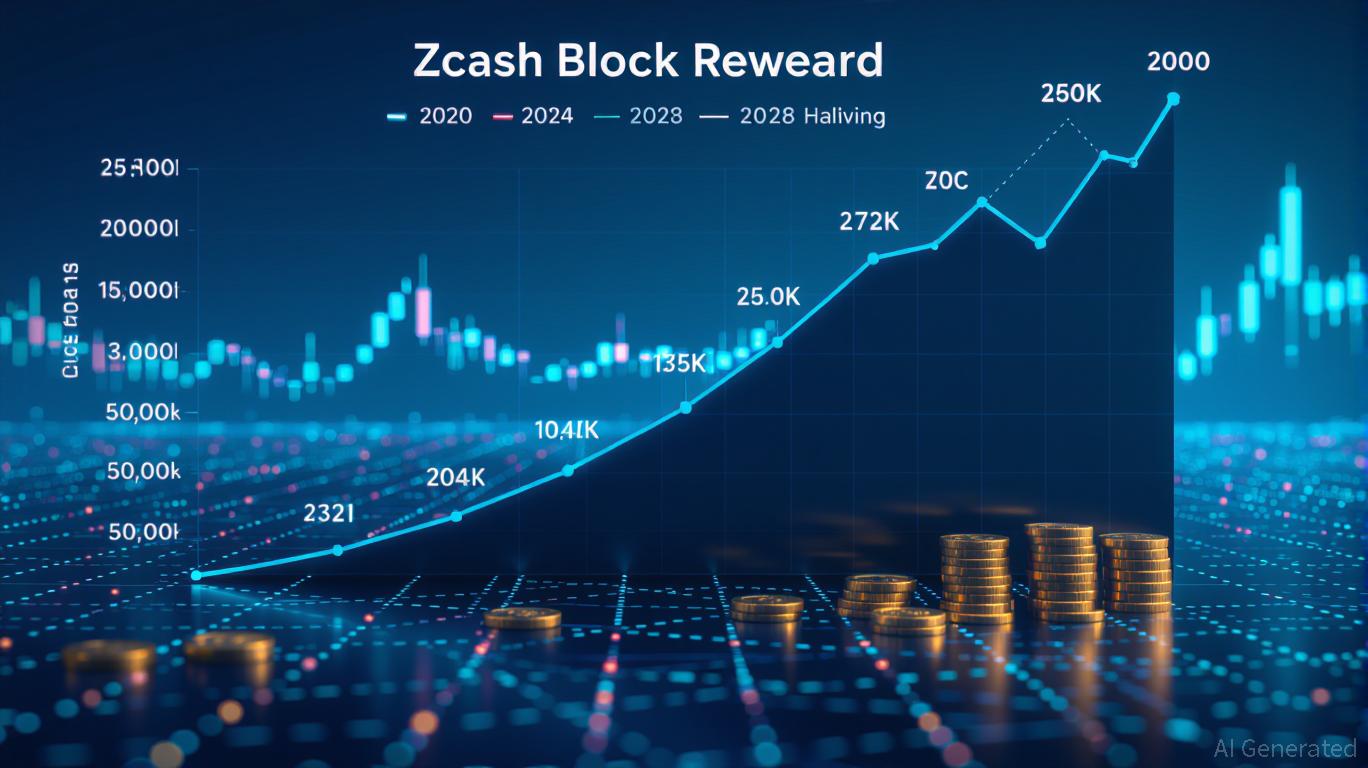Zcash Halving 2025: Impact on Cryptocurrency Markets and Investment Approaches
- Zcash's next halving in late 2028 will cut block rewards to 0.78125 ZEC, accelerating its 21M supply cap. - Historical data shows 500%+ price surges post-halving, driven by scarcity and growing institutional adoption like Grayscale's $137M Zcash Trust. - Privacy-focused demand and counter-cyclical price trends highlight Zcash's unique role, though regulatory risks to shielded transactions persist. - Investors are advised to balance long-term positioning with diversification and monitor utility-driven upg
Blockchain Economics: Limiting Supply and Miner Motivation
Zcash implements a halving every four years, slashing block rewards by half after every 1,680,000 blocks are produced
While Zcash’s deflationary approach is similar to Bitcoin’s, it also introduces its own unique factors. By reducing the rate at which new coins are created, Zcash will see its annual inflation rate drop from 6.25% after 2024 to 4% by the end of 2025

Speculative Demand: Past Trends and Institutional Influence
Looking back, there is a notable link between Zcash halving events and significant price increases. The 2020 halving triggered a 500% surge in value, while the 2024 halving led to a 92% jump by the last quarter of 2025
Greater institutional involvement has also fueled speculative interest. The introduction of the $137 million Grayscale Zcash Trust in 2025
Market Behavior: Divergent Trends and Regulatory Challenges
Zcash’s price movements often contrast with Bitcoin’s, especially during bearish markets. In late 2025, ZEC climbed 750% as investors turned to privacy coins while Bitcoin experienced turbulence
Privacy coins like Zcash continue to face uncertain regulatory environments. Although the SEC’s 2025 decision to exempt PoW mining from securities regulations
Investor Strategies: Key Points to Consider
For those investing in Zcash, understanding the interplay between limited supply, speculative forces, and regulatory uncertainty is essential. Recommended approaches include:
1. Long-Term Holding: With Zcash’s supply steadily decreasing, maintaining positions through multiple halving cycles could offer cumulative returns.
2. Portfolio Diversification: Spreading investments across Zcash and other privacy coins or
3. Tracking Network Developments: Innovations like Zashi and CrossPay may drive demand based on utility, independent of speculative trends
Conclusion
Zcash’s halving cycle provides valuable insight into both blockchain economics and speculative market behavior. Although the next halving is slated for 2028, the aftermath of the 2024 event—characterized by institutional participation and price stability—demonstrates Zcash’s promise as a privacy-oriented asset and a potential store of value. Investors should carefully balance these opportunities with the risks posed by regulatory shifts and market volatility, ensuring their strategies are in step with broader economic trends and the ongoing evolution of the Zcash ecosystem.
Disclaimer: The content of this article solely reflects the author's opinion and does not represent the platform in any capacity. This article is not intended to serve as a reference for making investment decisions.
You may also like
ZEC drops 11.51% over 24 hours, Large Holder Movements and Accumulation Patterns Indicate Market Fluctuations
- ZEC fell 11.51% in 24 hours as a major whale liquidated 30,000 ZEC ($960K), facing 46% unrealized losses and a $420 liquidation price. - Binance saw $30M ZEC accumulation via coordinated whale buys, while the largest short position (0xd47) reduced losses to $10.87M amid ongoing bearish bets. - Zcash’s November 2025 halving will cut block rewards by 50%, boosting scarcity, while Grayscale’s $137M Zcash Trust highlights growing institutional interest. - Privacy-focused Zcash gains regulatory clarity under
Bitcoin News Update: Short Sellers Hit Hard as $341M in Crypto Liquidations Sparks Volatility Spike
- Bitcoin's $106,000 surge triggered $341.85M in crypto liquidations, with short sellers losing $106.75M as leverage-driven volatility spiked. - Senate's shutdown resolution boosted Bitcoin 3.93% in 24 hours, alleviating regulatory uncertainty and injecting market optimism. - Hyperliquid's $18.96M single liquidation highlighted risks of 1,001:1 leverage, as platforms amplified price swings through stop-loss mechanisms. - November's $20B in crypto derivatives liquidations revealed systemic fragility, with E
XRP News Today: XRP ETFs: Wall Street's Pathway to a $6 Trillion Ambition
- U.S. regulators fast-track XRP ETF approvals, with 21Shares, Franklin Templeton, and Canary Capital nearing launches by late November. - Analysts predict XRP could surge to $100–$1,000 if multiple ETFs debut simultaneously, potentially pushing its market cap to $6 trillion. - Ripple's $4B funding round and SEC court rulings validate XRP's utility in cross-border payments, signaling institutional adoption. - Risks persist, including regulatory delays and unmet adoption targets, though ETFs could normalize

Bitcoin News Update: As AI Sparks a Modern Gold Rush, Bitcoin Miners Shift Focus from Blocks to Bytes
- Bitcoin miners like CleanSpark pivot to AI/HPC as mining profitability declines, raising $1.15B for infrastructure expansion and share buybacks. - Industry peers TeraWulf and Core Scientific expand HPC capacity, shifting valuation focus to AI hosting revenue ($1.5-2M/MW/year) over hashrate growth. - Regulatory hurdles and GPU shortages challenge AI infrastructure scaling, but long-term demand projects U.S. data-center electricity use to hit 606 TWh by 2030. - Hybrid crypto-AI infrastructure becomes a sca
